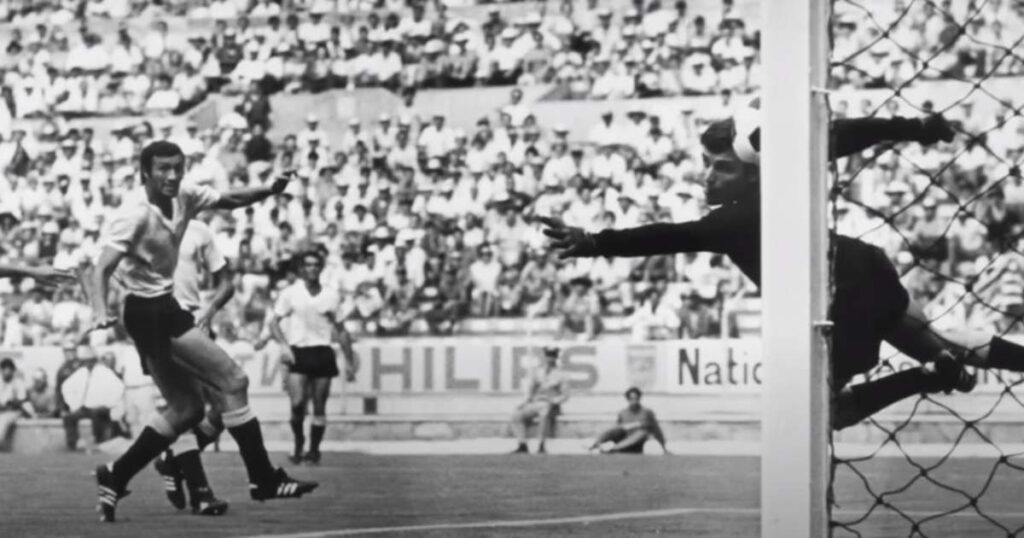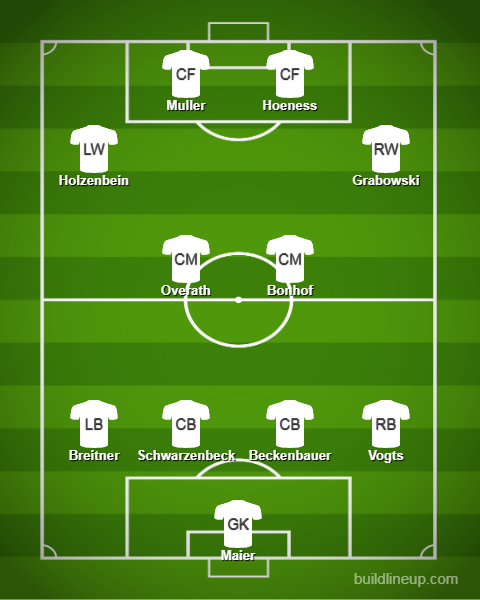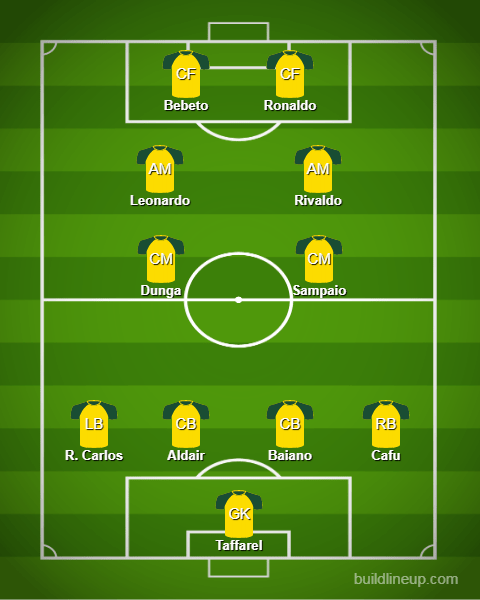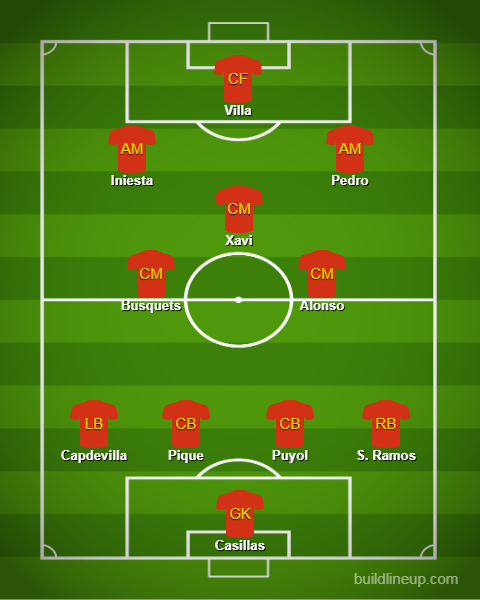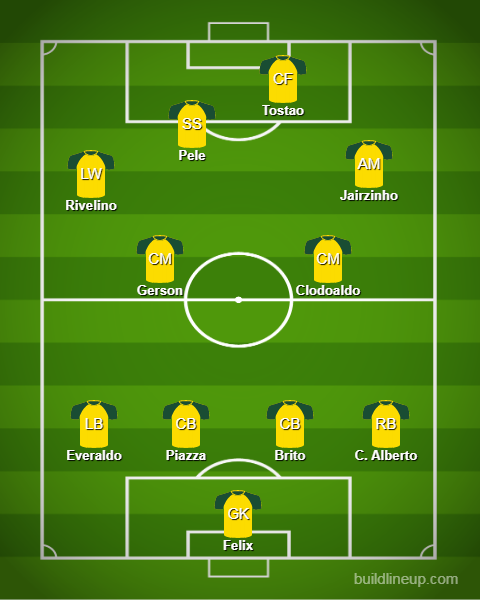Football has been played since the 19th century. Throughout its rich history, there’ve been many phenomenal national football teams. Since the first-ever international match played between Scotland and England in 1872, international football has always been a delight to watch.
But who are the best of the best national football teams?
In this review, I’ll cover the top 10 international teams that ever graced the football pitch.
It’s challenging to determine which teams are the cream of the crop of international football, but the factors that I’ll consider are their impact on the game, their style of play, and the number of trophies they lifted.
Sit back and enjoy your read!
#10 – West Germany 1972-1974
Trophies: 2
Lineup: Maier – Beckebauer – Scwarzenbeck – Vogts – Breitner – Bonhof – Overath – Hoeness – Grabowski – Holzenbein – Muller (1974 World Cup Final)
Formation: 4-2-4
The list starts with a memorable national team of West Germany that’s been a dominant side since the beginning of the ’70s. In 1972, they lifted the UEFA Euro Cup trophy when they dominated the Soviet Union and won 3-0.
The team’s backbone was the superb sweeper Franz Beckenbauer, who was a nightmare for every striker on the pitch.
Meanwhile, Gerd Muller was the prolific forward who bagged 68 goals in 62 matches while he played for West Germany. Other notable players were the excellent shot-stopper Sepp Maier and the midfield maestro Wolfgang Overath.
In 1974, West Germany faced the legendary Netherlands. In the 1970s, the Dutch team was led by the mighty Cruyff, and with the revolutionizing “Total Football” style, they were unstoppable. That was, up until the 1974 World Cup finals. As the hosts, West Germany won this cup by winning 2-1 against the Netherlands.
In their prime years from 1972 to 1974, the West Germany team was a football powerhouse.
#9 -Germany 2012-2014
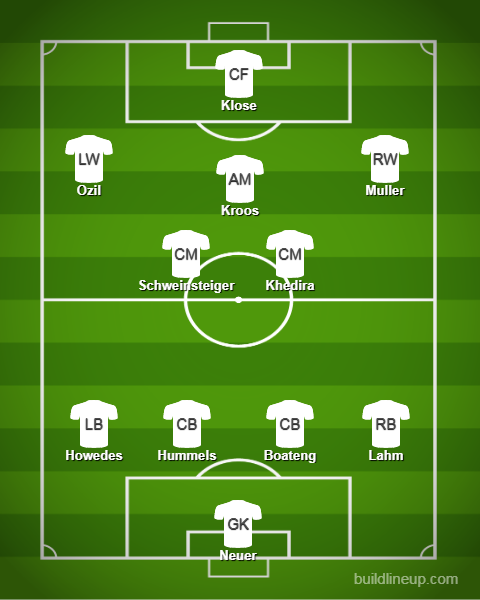
Lineup: Neuer – Boateng – Hummels – Lahm – Howedes – Khedira – Schweinsteiger – Khedira – Muller – Kroos – Ozil – Klose (2014 World Cup)
Formation: 4-2-3-1
Germany has been very successful as an international football team, with four FIFA World Cups and three UEFA EURO Cups. Also, they had more than a few good individual teams throughout the years.
One of Germany’s best teams was the squad from 2012 to 2014. It was a mix of players of all generations, from veterans like Miroslav Klose( top World Cup goal-scorer with 16 goals in 24 appearances), Bastian Schweinsteiger, and Phillip Lahm to the rising football stars such as Toni Kroos, Thomas Muller, and Mesut Ozil.
Before the semi-final loss to Italy at the UEFA EURO 2012 Cup, Germany won 15 consecutive matches in all competitions. As it turned out, that loss was a minor setback since they went on a streak of being unbeaten in 18 games. Among those 18 matches was the historic 2014 FIFA World Cup semi-final win over Brazil when the Germans destroyed them 7-1.
In the finals, Germany played against the Messi-led Argentina and came out on top in a nailbiting match, with 1-0 after the final whistle. The 22-year-old youngster, Mario Gotze, scored the winning goal in extra time.
In the modern-day era of international football, the 2012-2014 Germany national team is among the few that looked like a well-oiled machine when they played.
#8 – France 1998-2000
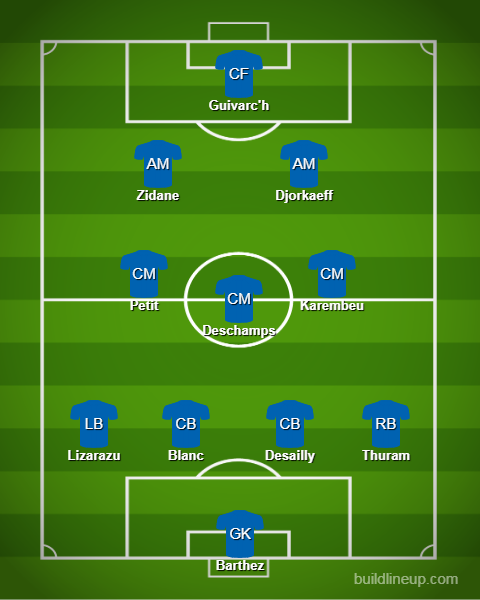
Lineup: Barthez – Desailly – Blanc – Thuram – Lizarazu – Karembeu – Deschamps – Petit – Djorkaeff – Zidane – Guivarc’h (1998 World Cup)
Formation: 4-5-1
France has always been a renowned international football team, but from 1998 to 2000, they were simply the most powerful squad on the planet. In those two years, the French team had an all-around fascinating squad, starting from the players in their prime, like Marcel Desailly, Didier Deschamps, and Lilian Thuram, to up-and-coming stars like Thierry Henry, David Trezeguet, and Patrick Vieira. All these players were crucial in France’s success, but the most important player for this team was the legendary playmaker Zinedine Zidane.
In 1998, France played the World Cup on their home soil. Before the finals, they encountered Italy in the quarter-finals and Croatia in the semi-finals. These were tough matches, but France managed to advance to the finals against Brazil.
The Brazil team was full of superstars like Ronaldo, Rivaldo, Cafu, and Roberto Carlos. The French team wasn’t afraid of Brazil’s star-studded team since Zidane put a masterclass by scoring two goals, and Petit put a final nail to the coffin with a goal to seal the 3-0 victory. This was the first World Cup that France won.
In the UEFA EURO 2000, the French side was even better as the young players matured. On their way to the finals, they beat strong teams like the Netherlands and Portugal. In the finals, France defeated Italy 2-1 in impressive fashion when David Trezeguet netted a goal in extra time.
The 1998-2000 French team goes down as one of the best national football teams ever.
#7 – Netherlands 1974-1978
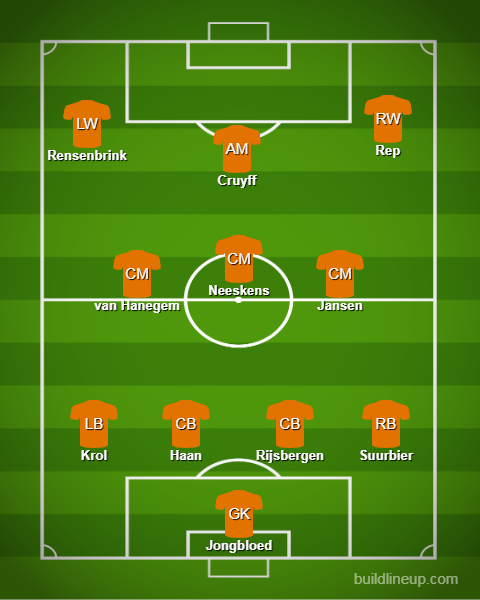
Lineup: Jongbloed – Haan – Rijsbergen – Suurbier – Krol – Jansen – Neeskens – van Hanegem – Rep – Cruyff – Rensenbrink (1974 World Cup Final)
Formation: 4-3-3
Surprisingly, the Netherlands national football team, which was remarkable in the 1970s, didn’t win a big tournament. When it comes to the EURO Cups, they were third in 1976. As for the World Cups, the Dutch team unfortunately lost in two finals, in 1974 and 1978. The most painful loss was in the 1974 finals when they were toying with West Germany, but they couldn’t get the best of them.
Neeskens scored the penalty in the opening minutes of the match, and instead of playing it safe, the Dutch were arrogant since they played aggressively, which cost them the win. In the 1978 World Cup final, the Netherlands played 1-1 against Argentina during the regular time. Unfortunately, the Dutch gave in the extra time when the Argentinians scored two goals and won 3-1.
Putting aside these losses, this team was a force to be reckoned with and aesthetically pleasing to watch.
The visionary coach, Rinus Michels, invented the “Total Football” playing style the Dutch team used in their matches. That was an attacking brand of football, based on quick position switching to create space for more chances that could lead to goals.
The team leader was Johan Cruyff, a player with immense technique that radiated elegance on the pitch. This team was full of talents like the defender Ruud Krol, midfielder Johan Neeskens, and the forward Johnny Rep.
Even though they didn’t win a trophy from 1974 to 1978, the Netherlands national football team is remembered for their sleek and stylish playing style and always putting on a show when they played.
#6 – Brazil 1998-2002
Trophies: 2
Lineup: Taffarel – Junior Baiano – Aldair – Cafu – R. Carlos – Sampaio – Dunga – Leonardo – Rivaldo – Bebeto – Ronaldo (1998 World Cup Final)
Formation: 4-2-2-2
There’s no doubt that Brazil is the most successful national football team in history,. They won five World Cups and 9 Copa America trophies. What’s also important to say is they had many superb teams in different eras of football. One of those teams was the Brazil team, which played from 1998 until 2002. There were a lot of big names on that team, like Ronaldo, Rivaldo, Ronaldinho, Roberto Carlos, Cafu and Dunga.
In 1998, many football fans thought that Brazil could win the World Cup. However, with Ronaldo suffering a convulsive fit and unable to play, Brazil was left without their superstar and eventually lost to France 3-0 in the 1998 FIFA World Cup Final.
In 1999, Brazil won the Copa America 3-0, with Rivaldo scoring a masterful hat-trick against Uruguay in the final.
In 2002, Brazil was led by the fearsome trio of R’s: Ronaldinho, Ronaldo, and Rivaldo. These three players had fascinating attacking prowess that often left spectators in awe. Cafu and Roberto Carlos, one of the best full-back duos in history, backed up this trio on the flanks.
In the final game of the 2002 FIFA World Cup, Brazil was up against Germany. Scoring the only two goals in the match, Ronaldo cemented his legacy as one of the legends of football.
The 1998-2002 Brazil national football squad was among the best in history and had a magical, one-of-a-kind style of play.
#5 – Italy 1934-1938
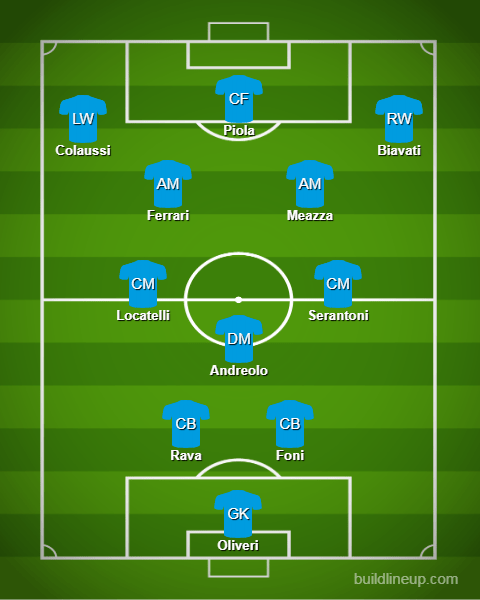
Lineup: Oliveri – Foni – Rava – Andreolo – Serantoni – Locatelli – Meazza – Ferrari – Biavati – Piola – Colaussi (1938 World Cup Final)
Formation: 2-3-2-3
Even though Italy didn’t play in the first World Cup in 1930, they won back-to-back World Cups in 1934 as well as in 1938 and became the first European champions.
Under the coaching virtuoso Vittorio Pozzo, Italy played in his Meotodo formation 2-3-2-3 based on solidity in defense and the ability to make efficient counter-attacks. In the 1934-1938 period, the most notable players were the forwards Ferrari, the legendary Giuseppe Meazza, striker Piola, the 1934 defensive duo Monzeglio and Allemandi, as well as the 1938 duo in the defense Rava and Foni.
In 1934, Italy won 2-1 in the finals against Czechoslovakia on home soil. Unfortunately, their success was overshadowed by the notorious dictator Mussolini, who used the tournament to promote his fascist ideas. Also, some controversial decisions were made by the referees during the tournament.
Four years later, Italy showed their dominance, beating Hungary 4-2 in the finals and lifting the FIFA 1938 World Cup.
The controversy surrounding the 1934 World Cup may have tarnished Italy’s success, but no one can deny that the Italian team from 1934-1938 was the best in the world at that moment.
#4 – Brazil 1958-1962
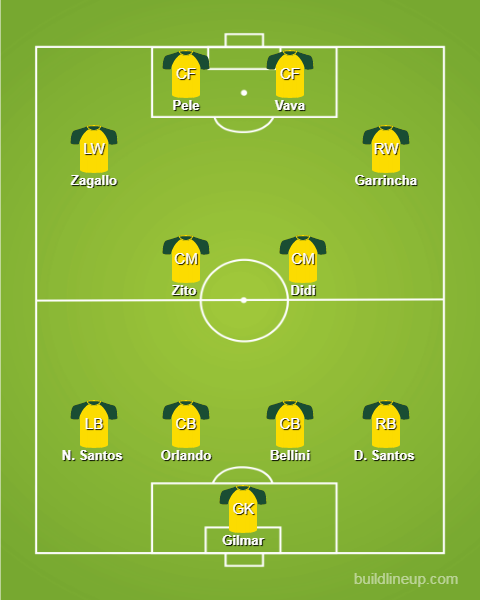
Lineup: Gilmar – Bellini – Orlando – D. Santos – N. Santos – Zito – Didi – Garrincha – Zagallo – Pele – Vava (1958 World Cup Final)
Formation: 4-2-4
The no.4 spot on the list goes to the golden generation of Brazil players that won two back-to-back World Cups in 1958 and 1962. The most dominant players in that era were two legends of the game, Pele and Garrincha.
They had star players in basically all positions except the central defense. Apart from being a dominant side, Brazil revolutionized the game. They were the first team to introduce the four-men back line, with two full-backs that helped the team in the attack on the flanks.
Interestingly, they were among the first national teams to use sšprts psychologists to improve their game.
As for the 1958 FIFA World Cup, the most exciting player was the 17-year-old Pele, who scored two goals in a sensational 5-2 victory against Sweden in the finals. In 1962, Pele got injured in the tournament’s second match, but Brazil didn’t weaken at all. Garrincha was the star player for Brazil, who put out an impressive performance in a 3-1 win over Czechoslovakia.
Brazil was always a solid national football team. Still, the 1958-1962 squad was one of the best national football teams in history.
#3 – Spain 2008-2012
Trophies: 3
Lineup: Casillas – Puyol – Pique – Ramos – Capdevilla – Alonso – Busquets – Xavi – Pedro – Iniesta – Villa (2010 World Cup Final)
Formation: 4-2-3-1
From 2008 to 2012, Spain was a great national football team. They played a football based on possession, known as the famous “tiki-taka” style of play. Spaniards knew how to control the ball and keep the opposing players from taking it.
The players from this Spain era were predominantly a mix of Real Madrid and Barcelona players. There were many players worth mentioning, but the ones who were most valuable to this team were the goalkeeper Iker Casillas, defenders Carles Puyol and Sergio Ramos, strikers David Villa and Fernando Torress, and the heartbeat of this team, midfielders Xavi and Andres Iniesta.
Spanish world dominance began when they defeated Germany 1-0 in the UEFA 2008 EURO Final, with Torres scoring the only goal in the match. Then, Spain took the football world by storm in the FIFA 2010 World Cup when a late win by Andres Iniesta cemented the legacy of this Spanish team as one of the best ever.
This wasn’t the end of great success as they won the UEFA 2012 EURO Cup when they thrashed Italy in the final by 4-0.
This was a true golden generation of Spanish players who will forever be remembered as part of one of the greatest national soccer teams ever.
#2 – Hungary 1950-1956
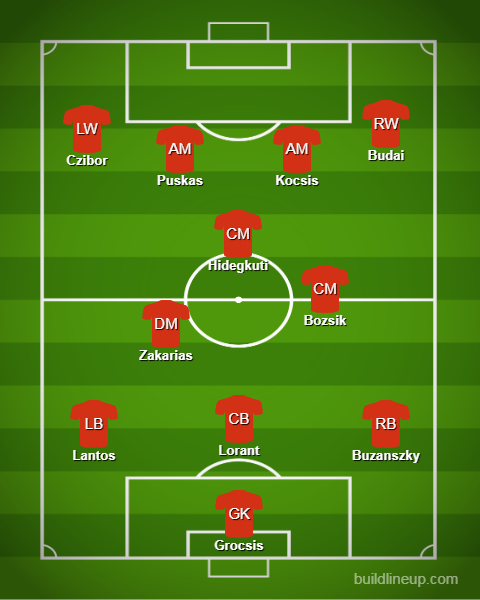
Lineup: Grocsis – Lorant – Buzanszky – Lantos – Bozsik – Zakarias – Hidegkuti – Kocsis – Puskas – Budai – Czibor (vs. England 1953)
Formation: 3-2-1-4
The 1950s Hungary team was better known as the “Magical Magyars” or the “Golden Team.” The superstars of this Hungary team were Sandor Kocsis, Nandor Hidegkuti, Jozsef Bozsik, Laszlo Kubala, and the legendary Ferenc Puskas. Sandor Kocsis was outstanding for Hungary, scoring 75 goals in 68 matches. The exceptional Puskas netted 84 goals in 85 appearances for the “Golden Team.”
Hungary is greatly credited for using an early version of the well-known “Total Football” style, whose premise was that players covered multiple positions on the pitch and switched positions between each other.
From 1950 to 1956, Hungary played 50 games. They won 42 games and had seven draws during that period. In those six years, they recorded jaw-dropping wins, like beating England 6-3 and 7-1, South Korea 9-0, and the mighty West Germany 8-3. The only loss from those 50 games came in the 1954 FIFA World Cup Final when West Germany miraculously beat the “Mighty Magyars” 3-2. This Hungary squad is widely regarded as the best national soccer team not to lift the FIFA World Cup trophy.
However, they weren’t trophyless from 1950 to 1956. They won the Olympic goal medal in Helsinki in 1952 when they beat Yugoslavia in the finals. Also, they lifted the 1948-1953 European Central Cup.
#1 – Brazil 1970
Trophies: 1
Lineup: Felix – Brito – Piazza – Everaldo – Carlos Albert – Clodoaldo – Gerson – Rivelino – Pele – Tostao – Jairzinho
Formation: 4-2-4
There sure were other national football teams with longer-lasting periods of success, but no other squad was so dominant as Brazil at the FIFA 1970 World Cup. Fans worldwide could watch the flashy Brazilians in color, unlike in 1958 and 1962, when matches were shown in black-and-white on small screens.
Brazil was led by Pele, one of the greatest players ever. Apart from him, many high-caliber players were a part of this Brazil side, like Tostao, Jairzinho, Gerson, and the team’s captain, Carlos Alberto. In 1970, this team only lost one match out of 14 and scored 34 goals in those 14 games.
The cherry on top of Brazil’s success in 1970 was when they put a masterclass performance of style and elegance against Italy in the finals, destroying them 4-1. The most memorable goal of the tournament was when Pele gave a pass to Carlos Alberto, who then made a clean shot in the bottom corner to score a beautiful goal.
Many national football teams today aspire to become great, like the Brazil 1970 squad.
Featured image taken from YouTube.
- The 1958 NFL Championship and “The Greatest Game Ever Played” – TBT #24 - May 15, 2025
- Youngster Pele’s World Cup Final Performance Leaves Everyone in Awe – TBT #23 - November 14, 2024
- Ranking the Top 10 Worst NBA Trades Ever – Biggest Regrets That NBA Teams Made - November 13, 2024
